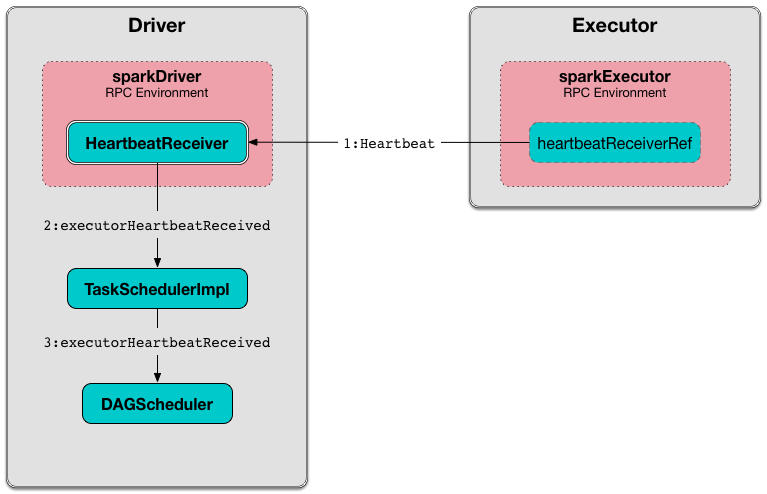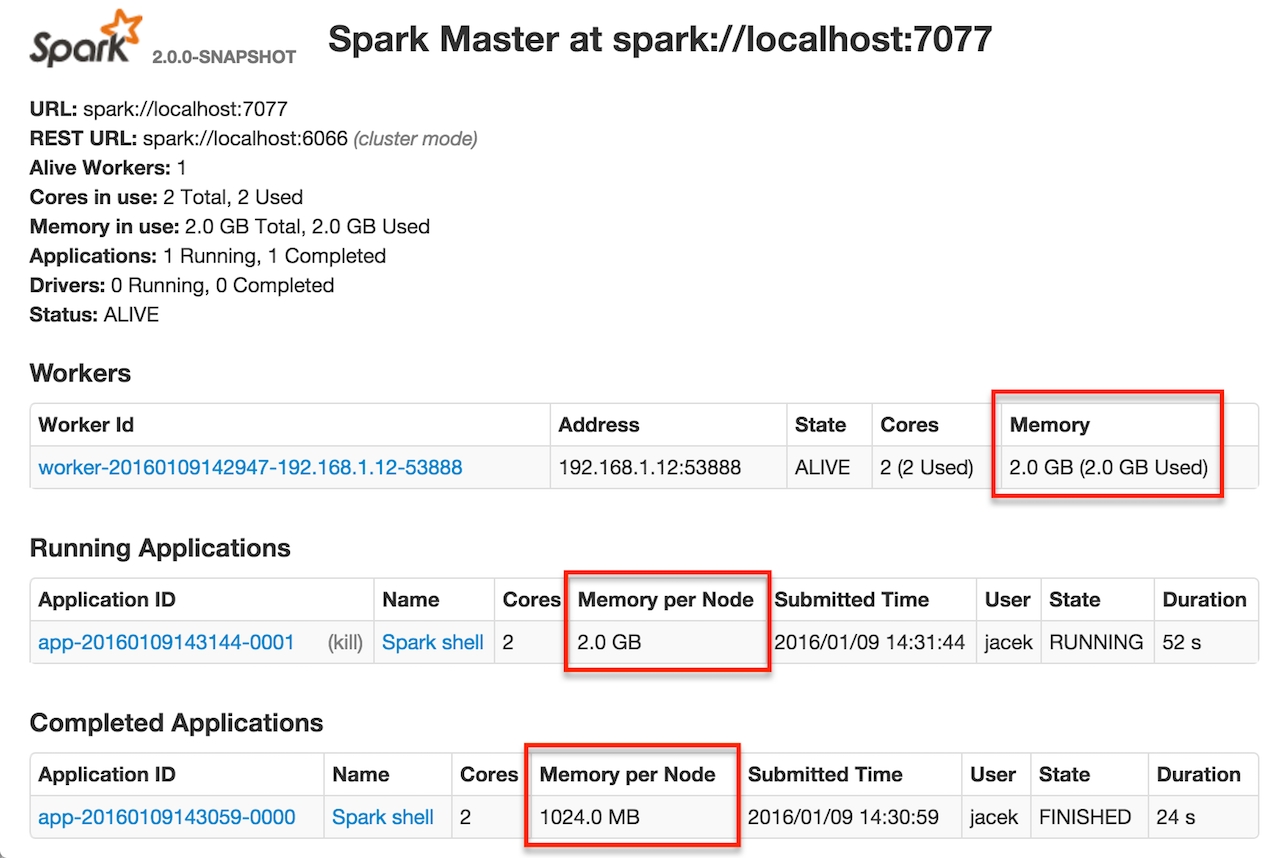log4j.logger.org.apache.spark.executor.Executor=INFOExecutors
Executors are distributed agents that execute tasks.
They typically run for the entire lifetime of a Spark application which is called static allocation of executors (but you could also opt in for dynamic allocation).
Executors send active task metrics to the driver and inform executor backends about task status updates (including task results).
|
Note
|
Executors are managed exclusively by executor backends. |
Executors provide in-memory storage for RDDs that are cached in Spark applications (via Block Manager).
When executors are started they register themselves with the driver and communicate directly to execute tasks.
Executor offers are described by executor id and the host on which an executor runs (see Resource Offers in this document).
Executors can run multiple tasks over its lifetime, both in parallel and sequentially. They track running tasks (by their task ids in runningTasks internal registry). Consult Launching Tasks section.
Executors use a thread pool for launching tasks and sending metrics.
It is recommended to have as many executors as data nodes and as many cores as you can get from the cluster.
Executors are described by their id, hostname, environment (as SparkEnv), and classpath (and, less importantly, and more for internal optimization, whether they run in local or cluster mode).
|
Caution
|
FIXME How many cores are assigned per executor? |
| Name | Description |
|---|---|
|
Tip
|
Enable Add the following line to Refer to Logging. |
Stopping Executor — stop Method
|
Caution
|
FIXME |
createClassLoader Method
|
Caution
|
FIXME |
addReplClassLoaderIfNeeded Method
|
Caution
|
FIXME |
Creating Executor Instance
Executor takes the following when created:
-
executorId -
executorHostname -
userClassPath— a collection of URLs (empty by default) -
isLocal— whether it runs in local or cluster mode (disabled by default, i.e. cluster is preferred)
|
Note
|
isLocal is enabled exclusively for LocalEndpoint (for Spark in local mode).
|
When created, you should see the following INFO messages in the logs:
INFO Executor: Starting executor ID [executorId] on host [executorHostname](only for non-local mode) Executor sets SparkUncaughtExceptionHandler as the default handler invoked when a thread abruptly terminates due to an uncaught exception.
(only for non-local mode) Executor registers ExecutorSource and initializes the local BlockManager.
|
Note
|
Executor uses SparkEnv to access the local MetricsSystem and BlockManager.
|
Executor creates a task class loader (possibly with REPL support) and requests the current Serializer to use it.
|
Note
|
Executor uses SparkEnv to access the local Serializer.
|
Executor initializes the internal registries and counters in the meantime (not necessarily at the very end).
|
Note
|
|
Launching Task — launchTask Method
launchTask(
context: ExecutorBackend,
taskId: Long,
attemptNumber: Int,
taskName: String,
serializedTask: ByteBuffer): UnitlaunchTask executes the input serializedTask task concurrently.
Internally, launchTask creates a TaskRunner, registers it in runningTasks internal registry (by taskId), and finally executes it on "Executor task launch worker" thread pool.

|
Note
|
launchTask is called by CoarseGrainedExecutorBackend (when it handles LaunchTask message), MesosExecutorBackend, and LocalEndpoint.
|
Sending Heartbeats and Active Tasks Metrics — startDriverHeartbeater Method
Executors keep sending metrics for active tasks to the driver every spark.executor.heartbeatInterval (defaults to 10s with some random initial delay so the heartbeats from different executors do not pile up on the driver).

An executor sends heartbeats using the internal heartbeater - Heartbeat Sender Thread.

For each task in TaskRunner (in runningTasks internal registry), the task’s metrics are computed (i.e. mergeShuffleReadMetrics and setJvmGCTime) that become part of the heartbeat (with accumulators).
|
Caution
|
FIXME How do mergeShuffleReadMetrics and setJvmGCTime influence accumulators?
|
|
Note
|
Executors track the TaskRunner that run tasks. A task might not be assigned to a TaskRunner yet when the executor sends a heartbeat. |
A blocking Heartbeat message that holds the executor id, all accumulator updates (per task id), and BlockManagerId is sent to HeartbeatReceiver RPC endpoint (with spark.executor.heartbeatInterval timeout).
|
Caution
|
FIXME When is heartbeatReceiverRef created?
|
If the response requests to reregister BlockManager, you should see the following INFO message in the logs:
INFO Executor: Told to re-register on heartbeatThe internal heartbeatFailures counter is reset (i.e. becomes 0).
If there are any issues with communicating with the driver, you should see the following WARN message in the logs:
WARN Executor: Issue communicating with driver in heartbeaterThe internal heartbeatFailures is incremented and checked to be less than the acceptable number of failures. If the number is greater, the following ERROR is printed out to the logs:
ERROR Executor: Exit as unable to send heartbeats to driver more than [HEARTBEAT_MAX_FAILURES] timesThe executor exits (using System.exit and exit code 56).
|
Tip
|
Read about TaskMetrics in TaskMetrics.
|
heartbeater - Heartbeat Sender Thread
heartbeater is a daemon ScheduledThreadPoolExecutor with a single thread.
The name of the thread pool is driver-heartbeater.
Coarse-Grained Executors
Coarse-grained executors are executors that use CoarseGrainedExecutorBackend for task scheduling.
Resource Offers
Read resourceOffers in TaskSchedulerImpl and resourceOffer in TaskSetManager.
"Executor task launch worker" Thread Pool — threadPool Property
Executor uses threadPool daemon cached thread pool with the name Executor task launch worker-[ID] (with ID being the task id) for launching tasks.
threadPool is created when Executor is created and shut down when it stops.
Executor Memory — spark.executor.memory or SPARK_EXECUTOR_MEMORY settings
You can control the amount of memory per executor using spark.executor.memory setting. It sets the available memory equally for all executors per application.
|
Note
|
The amount of memory per executor is looked up when SparkContext is created. |
You can change the assigned memory per executor per node in standalone cluster using SPARK_EXECUTOR_MEMORY environment variable.
You can find the value displayed as Memory per Node in web UI for standalone Master (as depicted in the figure below).

The above figure shows the result of running Spark shell with the amount of memory per executor defined explicitly (on command line), i.e.
./bin/spark-shell --master spark://localhost:7077 -c spark.executor.memory=2gMetrics
Every executor registers its own ExecutorSource to report metrics.
Settings
| Spark Property | Default Value | Description |
|---|---|---|
Number of cores for an executor. |
||
List of URLs representing a user-defined CLASSPATH. Each entry is separated by system-dependent path separator, i.e. |
||
Extra Java options for executors. Used to prepare the command to launch |
||
Extra library paths separated by system-dependent path separator, i.e. Used to prepare the command to launch |
||
|
Flag to control whether to load classes in user jars before those in Spark jars. |
|
|
Interval after which an executor reports heartbeat and metrics for active tasks to the driver. Refer to Sending heartbeats and partial metrics for active tasks in this document. |
|
|
Number of times an executor will try to send heartbeats to the driver before it gives up and exits (with exit code NOTE: It was introduced in SPARK-13522 Executor should kill itself when it’s unable to heartbeat to the driver more than N times. |
|
|
Number of executors to use. NOTE: A positive value disables dynamic allocation. |
|
|
Amount of memory to use per executor process (equivalent to SPARK_EXECUTOR_MEMORY environment variable). Refer to Executor Memory — spark.executor.memory or SPARK_EXECUTOR_MEMORY settings in this document. |
|
|
||
|
||
|
||
|
||
|
||
|
Equivalent to |
|
|